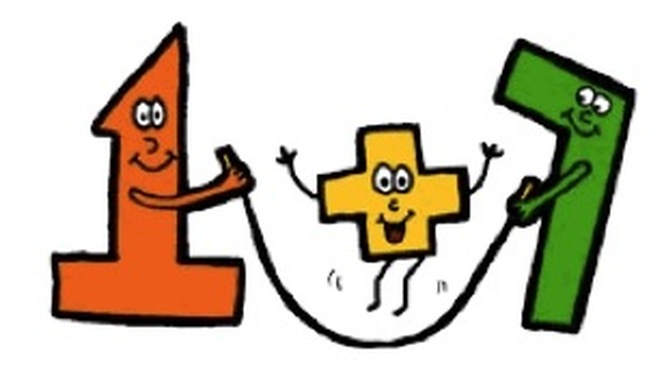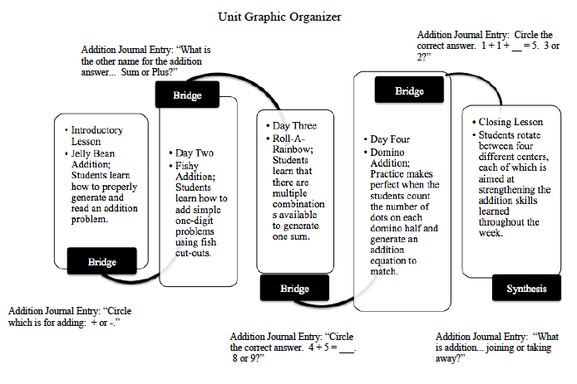A Kindergarten Unit on Addition

Unit Objective
Students will demonstrate mastery of setting up and solving double addend addition problems through a variety of teacher-designed formative assessments, as well as the accurate completion of a post-assessment given equation.
Students will demonstrate mastery of setting up and solving double addend addition problems through a variety of teacher-designed formative assessments, as well as the accurate completion of a post-assessment given equation.

This five-day unit on Addition is structured
around the student; the delivery of each lesson is given in a format conducive
to student learning through participation, student-to-student involvement,
practice of acquired knowledge, and the abundant availability of manipulatives
to help students reach a final sum.
Furthermore, during every “assessment” portion of each lesson, the
teacher makes herself available to help, encourage, and motivate students to
keep learning; in seeing that they are capable of adding numbers, students gain
confidence in themselves, which helps build classroom moral and overall
excitement.
The introductory lesson of this unit, entitled “Jelly Bean Introductory Lesson” focuses on giving the students the information necessary to add. No actual adding takes place during this lesson; rather, students learn the vocabulary and rules associated with adding. Using jellybeans for assistance, students gain insight on how to “set-up” and properly read an addition problem.
The closing lesson of this unit uses four different centers, each of which is aimed at strengthening the addition skills learned throughout the week. Working in groups and being under a “time crunch” spark the students’ competitive nature, and further compel them to work harder.
Active learning is a prime component to this unit. Students are constantly encouraged to participate in the lessons, and many opportunities to actively learn are presented in these lessons. Such opportunities include group work, videos, books, manipulatives (jellybeans, fish, dominoes, dice) and class presentations. Furthermore, these active learning opportunities also serve as strategies in which the teacher is able to monitor students for comprehension and understanding of the material.
Along with opportunities to actively learn comes an opportunity to practice. For their morning work, students are instructed to respond to a specific question in their “Addition Journals.” These questions have been pre-selected by the teacher, who goes over each question thoroughly before the students are instructed to respond. These questions are designed for students to practice their new knowledge, and feedback of each question is given daily. As motivation to work diligently and think accurately, students that respond correctly are awarded with a sticker in their journal. As incentive, the student(s) with the most stickers at the end of the week are rewarded with the addition of a larger sticker on their homework folder (this is a huge incentive to work diligently within the given [competitive] Kindergarten classroom). Through abundant practice and feedback, students have a greater chance to retain their new knowledge of addition.
The introductory lesson of this unit, entitled “Jelly Bean Introductory Lesson” focuses on giving the students the information necessary to add. No actual adding takes place during this lesson; rather, students learn the vocabulary and rules associated with adding. Using jellybeans for assistance, students gain insight on how to “set-up” and properly read an addition problem.
The closing lesson of this unit uses four different centers, each of which is aimed at strengthening the addition skills learned throughout the week. Working in groups and being under a “time crunch” spark the students’ competitive nature, and further compel them to work harder.
Active learning is a prime component to this unit. Students are constantly encouraged to participate in the lessons, and many opportunities to actively learn are presented in these lessons. Such opportunities include group work, videos, books, manipulatives (jellybeans, fish, dominoes, dice) and class presentations. Furthermore, these active learning opportunities also serve as strategies in which the teacher is able to monitor students for comprehension and understanding of the material.
Along with opportunities to actively learn comes an opportunity to practice. For their morning work, students are instructed to respond to a specific question in their “Addition Journals.” These questions have been pre-selected by the teacher, who goes over each question thoroughly before the students are instructed to respond. These questions are designed for students to practice their new knowledge, and feedback of each question is given daily. As motivation to work diligently and think accurately, students that respond correctly are awarded with a sticker in their journal. As incentive, the student(s) with the most stickers at the end of the week are rewarded with the addition of a larger sticker on their homework folder (this is a huge incentive to work diligently within the given [competitive] Kindergarten classroom). Through abundant practice and feedback, students have a greater chance to retain their new knowledge of addition.
